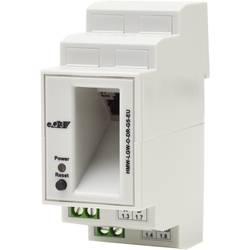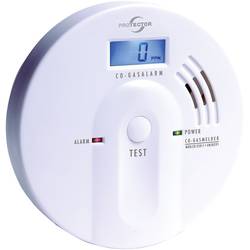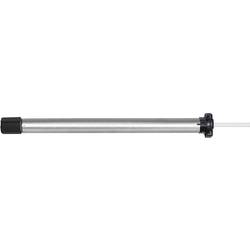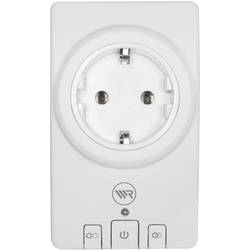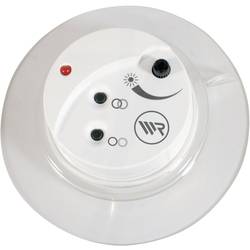€92.28
Priemerné hodnotenie:0/5(0x)
Vlastnosti a parametre výrobku
Skúsenosti užívateľov
Otázky a odpovede
Dokumentácia
Popis
Vlastnosti a parametre výrobku
| Séria (domáca technika) | Homematic |
|---|---|
| Cloudová integrácia (Smart Home) | Conrad Connect (CONRAD-CONNECT_SY_01) |
| Bezdrôtové zariadenie (Smart Home) | Hersteller-Spezifisch |
| Spôsob ochrany | IP20 |
| Prevádzkové napätie | 24 V/DC |
| Spôsob montáže | Klobúčikové tienidlo |
| Vonkajšia šírka | 35 mm |
| Vonkajšia výška | 87 mm |
| Rozmer, hĺbka | 64 mm |
| Hmotnosť | 76 g |
| Kategória výrobku | Brána LAN |
Skúsenosti a názory zákazníkov
- Skúsenosti užívateľov nie sú k dispozícii.
Otázky užívateľov
- Užívatelia k tomuto výrobku zatiaľ nemali žiadne otázky.
Dokumentácia
Podmienky používania dokumentácie
Installations- undBedienungsanleitung (S. 2) Installation andoperating manual (p. 26) RS485 LAN Gateway, Hutschienenmontage: RS485 LAN Gateway, for mounting on DIN rails: HMW-LGW-O-DR-GS-EU
2
1. Ausgabe Deutsch 03/2013Dokumentation © 2013 eQ-3 Ltd., Hong KongAlle Rechte vorbehalten. Ohne schriftliche Zustim-mung des Herausgebers darf dieses Handbuch auch nicht auszugsweise in irgendeiner Form reproduziert werden oder unter Verwendung elektronischer, mecha-nischer oder chemischer Verfahren vervielfältigt oder verarbeitet werden.Es ist möglich, dass das vorliegende Handbuch noch drucktechnische Mängel oder Druckfehler aufweist. Die Angaben in diesem Handbuch werden jedoch regelmäßig überprüft und Korrekturen in der nächsten Ausgabe vorgenommen. Für Fehler technischer oder drucktechnischer Art und ihre Folgen übernehmen wir keine Haftung.Alle Warenzeichen und Schutzrechte werden aner-kannt.Printed in Hong Kong.Änderungen im Sinne des technischen Fortschritts können ohne Vorankündigung vorgenommen werden.
103850 / V 1.0
3
Inhaltsverzeichnis 1 Hinweise zu dieser Anleitung…42 Gefahrenhinweise …43 Funktion . . . . . . . . . . . . . . . . . . . . . . . . . . . . . . 64 Allgemeine Systeminformation zu HomeMatic.95 Allgemeine Hinweise zum Bussystem . . . . . . 105.1 Allgemeine Hinweise zur Installation …105.2 Topologie des Bussystems…106 Installation …117 Einbinden ins Netzwerk (LAN)…198 Werkseinstellungen des Gerätes wieder herstellen …219 Deinstallation …2310 Wartung und Reinigung …2311 Lieferumfang …2412 Technische Daten…24
4
1 Hinweise zu dieser Anleitung Lesen Sie diese Anleitung sorgfältig, bevor Sie Ihre HomeMatic Komponenten in Betrieb nehmen. Bewah-ren Sie die Anleitung zum späteren Nachschlagen auf! Wenn Sie das Gerät anderen Personen zur Nutzung überlassen, übergeben Sie auch diese Bedienungs-anleitung.
Benutzte Symbole:Achtung! Hier wird auf eine Gefahr hingewie-sen.
Hinweis. Dieser Abschnitt enthält zusätzliche wichtige Informationen!
2 Gefahrenhinweise Das Gerät ist Teil einer Gebäudeinstallation. Bei der Planung und Errichtung von elektri-schen Anlagen sind die einschlägigen Normen und Richtlinien des Landes zu beachten, in dem die Anlage installiert wird.
Arbeiten an und in Niederspannungsanlagen dürfen nur von einer Elektro-Fachkraft (nach
5
VDE 0100) erfolgen. Dabei sind die geltenden Unfall-verhütungsvorschriften zu beachten. Zur Vermeidung eines elektrischen Schlages schalten Sie vor Arbeiten am Gerät die Netzspannung frei (Sicherungsautomat abschalten). Bei Nichtbeachtung der Installationshinweise können Brand oder andere Gefahren entste-hen (siehe Abschnitt 6).
Betreiben Sie das Gerät nur in Innenräumen und vermeiden Sie den Einfluss von Feuchtig-keit, Staub sowie Sonnen- oder andere Wär-mebestrahlung. Jeder andere Einsatz als in dieser Bedienungsanleitung beschrieben ist nicht bestimmungsgemäß und führt zu Garan-tie und Haftungsausschluss.
Öffnen Sie das Gerät nicht, es enthält keine durch den Anwender zu wartenden Teile. Das Öffnen des Gerätes birgt die Gefahr eines Stromschlages. Im Fehlerfall schicken Sie das Gerät an den Service.
Beachten Sie beim Anschluss an die Geräte – klemmen die hierfür zulässigen Leitungen und Leitungsquerschnitte.
6
Es ist strikt darauf zu achten, dass alle An- schlussleitungen räumlich getrennt von netz- spannungsführenden Leitungen verlegt wer-den (z. B. in eigenen Kabelkanälen oder Installationsrohren).
Beachten Sie die Installationsvorschriften für Installationen in Verteilersystemen (DIN VDE 0100-410).
3 Funktion Das HomeMatic RS485 Gateway ermöglicht die Kom-munikation zwischen HomeMatic Wired-Geräten und der HomeMatic Zentrale CCU2. Die Verbindung zur Zentrale wird per Ethernet hergestellt. Die Kommuni-kation zu den angeschlossenen Geräten erfolgt über das HomeMatic Wired-Protokoll.
7
(A) Power-LED(B) Reset-Taste(C) Ethernet-Buchse(D) Bus A(E) Bus B(F) Spannungsversorgung (+24 V)(G) Masse (GND) Übersicht A
B
C
DE
FG
Power Reset HMW-LGW-O-DR-GS-EU
A
1.3
B
1.7
+24 V
1.4
GND1.8
8
Das Gerät wird komfortabel auf einer Standard-Hutschiene in einer Elektroverteilung montiert. Durch Anlernen des HomeMatic RS485 Gateways an die HomeMatic Zentrale kann das HomeMatic Wired System flexibel von überall im Haus gesteuert werden. Die Kommunikation zwischen dem Gateway und der Zentrale ist über die im Haus bauseits vorhandene Netzwerk-Infrastruktur möglich, wodurch eine Ver-bindung über zusätzliche Busleitungen im Haus nicht nötig ist.
Die Kommunikation zwischen Gateway und Zentrale ist über zwei Varianten möglich: 1. Netzwerk-Installationskabel (Hutschienen-Patch-felder/Module): LANPC
Power Internet Info CCU2
InternetWiredGateway
9
2. Powerline-Kommunikation über 230V-Verkabe-lung (DINrail Powerline-Adapter): Powerline 230 V
Power Internet Info CCU2
WiredGateway PowerlineNetzteil 4
Allgemeine Systeminformation zu HomeMatic Dieses Gerät ist Teil des HomeMatic Haussteuer-systems. Alle im System installierten Geräte werden mit einer Standardkonfiguration ausgeliefert. Darüber hinaus ist die Funktion der Geräte über ein Program-miergerät und Software konfigurierbar. Welcher wei-tergehende Funktionsumfang sich daraus ergibt, und welche Zusatzfunktionen sich im HomeMatic System im Zusammenspiel mit weiteren Komponenten erge-ben, entnehmen Sie bitte dem HomeMatic System-handbuch. Alle technischen Dokumente und Updates finden Sie stets aktuell unter www.HomeMatic.com.
10
5 Allgemeine Hinweise zum Bussystem 5.1 Allgemeine Hinweise zur InstallationBeim Anschluss des RS485-Busses sind die A-Klem-men (1.3), die B-Klemmen (1.7), die 24 V Spannungs-versorgung (1.4) und die Masseklemme (1.8) der Module einer Unterverteilung (max. 127 Stück) jeweils miteinander zu verbinden. Ein Busabschluss ist für diese Installation immer erforderlich.
5.2 Topologie des BussystemsFür eine bessere Übersicht sollten die HomeMatic Wired-Komponenten immer gruppenweise in Unterver-teilungen montiert werden. Wie viele Unterverteilungen angemessen sind, hängt dabei von der Art und Größe des zu realisierenden Projektes ab und ist individuell festzulegen. Es ist auf jeden Fall zu empfehlen, auf jeder Etage mindestens eine Unterverteilung zu instal-lieren. Bei größeren Gebäuden kann es auch sinnvoll sein, mehrere Verteilungen pro Etage (z.B. separat für jeden Flur) vorzusehen. Zwischen den Verteilern ist die Busverkabelung und eine Masseverkabelung zu installieren. Entsprechend sind alle Last- und Steuer-leitungen sternförmig zu den entsprechenden Unter-verteilungen zu führen.
11
Die Stromversorgung erfolgt über ein 24V-Hut-schienen-Netzteil (24 VDC Netzteil mit stabilisierter Ausgangsspannung) entsprechend der Anzahl und Gesamtstromaufnahme aller vorhandenen Module in der jeweiligen Unterverteilung dimensioniert. Bitte entnehmen Sie die Daten der Leistungsaufnahme für einzelne Geräte der jeweiligen Bedienungsanleitung.
6 Installation Beachten Sie die Installationsvorschriften für das Errichten von Niederspannungsanlagen gemäß DIN VDE 0100-410.
Die Installation darf ausschließlich von Personen mit einschlägigen elektrotech-nischen Kenntnissen und Erfahrungen vorgenommen werden.
Wenden Sie sich an einen Elektroinstallateur! Erforderliche Fachkenntnisse für die Installation: Für die Installation sind insbesondere folgende Fach-kenntnisse erforderlich:
12
– Die anzuwendenden „5 Sicherheitsregeln“: – Freischalten; – gegen Wiedereinschalten sichern; – Spannungsfreiheit feststellen; – Erden und Kurzschließen; – benachbarte, unter Spannung stehende Teile abdecken oder abschranken; – Auswahl des geeigneten Werkzeuges, der Messge-räte und ggf. der persönlichen Schutzausrüstung; – Auswertung der Messergebnisse; – Auswahl des Elektro-Installationsmaterials zur Sicherstellung der Abschaltbedingungen; – IP-Schutzarten;- Einbau des Elektroinstallationsmaterials; – Art des Versorgungsnetzes (TN-System, IT-System, TT-System) und die daraus folgenden Anschluss-bedingungen (klassische Nullung, Schutzerdung, erforderliche Zusatzmaßnahmen etc.) Durch eine unsachgemäße Installation gefähr-den Sie Ihr eigenes Leben und das Leben der Nutzer der elektrischen Anlage.
Mit einer unsachgemäßen Installation riskieren Sie schwere Sachschäden, z.B. durch Brand. Es droht für Sie die persönliche Haftung bei Personen- und Sachschäden.
13
Es ist strikt darauf zu achten, dass alle An-schlussleitungen räumlich getrennt von netz-spannungsführenden Leitungen verlegt wer-den (z.B. in eigenen Kabelkanälen oder Installationsrohren). Alternativ können für diese niederspannungsführenden Leitungen doppelt isolierte Netzkabel verwendet werden.
Die maximalen Leitungslängen aller ange- schlossenen Leitungen sind je nach verwende-ter Leitung unterschiedlich. Eine Länge von 50 m darf allerdings nicht überschritten wer-den.
Für den sicheren Betrieb muss das Gerät in einen Stromkreisverteiler entsprechend VDE 0603, DIN 43871 (Niederspannungsunterver-teilung (NSUV)), DIN 18015-x eingebaut wer-den. Die Montage muss auf einer Tragschiene (Hutschiene, DIN-Rail) lt. EN50022 erfolgen. Installation und Verdrahtung sind entspre-chend VDE 0100 (VDE 0100-410, VDE 0100-510 usw.) durchzuführen. Es sind die Vor-schriften der Technischen Anschlussbe-stimmungen (TAB) des Energieversorgers zu berücksichtigen.
14
Zur Installation gehen Sie wie folgt vor:- Setzen Sie das HomeMatic RS485 Gateway oben mit den Rastnasen auf die Hutschiene auf. – Verrasten Sie das Gerät, indem Sie es nach unten drücken.- Achten Sie darauf, dass die Rastnasen komplett einrasten und das Gerät fest auf der Schiene sitzt.
– Isolieren Sie die Drahtenden der Leitung zum Netz-teil und der Busleitung auf eine Länge von 8 mm ab, ohne dabei die blanke Ader zu verletzen.
15
Beachten Sie die zugelassenen Leitungsquerschnitte: starre Leitung [mm2]flexible Leitung mit Aderendhülse [mm2] 0,14 – 2,500,14 – 1,5
– Verdrahten Sie das HomeMatic RS485 Gateway zur Spannungsversorgung mit dem Netzteil an den Klemmen 1.4 (24 VDC) und 1.8 (GND). Achten Sie dabei strikt auf den polaritätsrichtigen Anschluss an den Klemmen.
Power Reset HMW-LGW-O-DR-GS-EU
A
1.3
B
1.7
+24 V
1.4
GND1.8
16
– Schließen Sie das HomeMatic RS485 Gateway mit dem RS485-BUS an die Klemmen 1.3 (A) und 1.7 (B) an.
– Stecken Sie das beiliegende Ethernet-Kabel in die dafür vorgesehene Buchse (C).
Power Reset HMW-LGW-O-DR-GS-EU
A
1.3
B
1.7
+24 V
1.4
GND1.8
Power Reset HMW-LGW-O-DR-GS-EU
A
1.3
B
1.7
+24 V
1.4
GND1.8
17
Um eine sichere Bedienung des Gerätes ge-währleisten zu können, wird ein Ethernetkabel mit mindestens der Kategorie 5 (CAT5 FTP) benötigt.
– Vergewissern Sie sich, dass alle Anschlüsse fest und sicher in den Installationsklemmen fixiert sind.
Die Integration eines HomeMatic Wired RS485 Busabschluss Widerstandes ist zwingend erforderlich.
18
Anschluss- und Installationsbeispiel: KlemmeFunktion1.3RS485-BUS, Leitung A1.4Versorgungsspannung, +24 V1.7RS485-BUS, Leitung B1.8Versorgungsspannung, Masse (GND), Massebezug für alle Eingänge A
B+24V / SELVGND
19
7 Einbinden ins Netzwerk (LAN) Um eine Kommunikation zwischen Ihrer HomeMatic Zentrale und den HomeMatic Wired-Geräten herzu-stellen, muss das HomeMatic Wired RS485 Gateway ins Netzwerk eingebunden werden. Dazu gehen Sie bitte wie folgt vor: Einrichten über die HomeMatic Zentrale- Öffnen Sie die Bedienoberfläche WebUI in Ihrem Webbrowser.- Klicken Sie in der Bedienoberfläche WebUI auf „Einstellungen“ „Systemsteuerung“ „LAN-Gateway Konfiguration“.- Klicken Sie im nächsten Fenster unter „Allgemeine Einstellungen“ auf den Button „Hinzufügen“.
– Wählen Sie im nächsten Fenster den Typ „Wired: HomeMatic RS485 Gateway“ aus. Geben Sie an-schließend die Seriennummer und den Sicherheits-
20
schlüssel Ihres HomeMatic Wired RS485 Gateways ein. Diese können Sie den Aufklebern auf Ihrem HomeMatic Wired RS485 Gateway entnehmen und später ändern.
– Bestätigen Sie Ihre Eingaben mit „OK“ und klicken Sie im nächsten Fenster auf „Übernehmen“.- Das Gateway wurde erfolgreich ins Netzwerk ein-gebunden, wenn die IP-Adresse angezeigt wird und der Status „verbunden“ ist.
– Starten Sie abschließend Ihre HomeMatic Zentrale neu.
21
Um einzelne HomeMatic Wired Geräte in das System einbinden zu können, gehen Sie bitte wie in den dazugehörigen Bedienungsanlei-tungen beschrieben vor.
Einzelheiten zu Netzwerkproblemen (z. B. kein DHCP) finden Sie im FAQ-Bereich auf der Website www.HomeMatic.com 8 Werkseinstellungen des Gerätes wieder herstellen Die Werkseinstellungen des HomeMatic RS485 Gateways können manuell wieder hergestellt werden. Dabei gehen alle Einstellungen und Informationen verloren.
Bevor Sie die Werkseinstellungen des Gerätes wieder herstellen, löschen Sie es zuerst aus der HomeMatic Bedienoberfläche WebUI.
Um die Werkseinstellungen wieder herzustellen, gehen Sie wie folgt vor:- Drücken Sie die Reset-Taste für ca. 6 Sekunden. Die schnell blinkende LED zeigt den Löschmodus an.
22
– > 6 Sek.
Lassen Sie die Taste los.- Drücken Sie die Taste erneut für ca. 3 Sekunden, bis die LED sehr langsam blinkt.
> 3 Sek.
– Lassen Sie die Taste los.- Die LED erlischt nach kurzer Zeit und die Werksein-stellungen des Gerätes sind wieder hergestellt.
Power Reset HMW-LGW-O-DR-GS-EU
A
1.3
B
1.7
+24 V
1.4
GND1.8
Power Reset HMW-LGW-O-DR-GS-EU
A
1.3
B
1.7
+24 V
1.4
GND1.8
23
9 Deinstallation – Zur Demontage des HomeMatic RS485 Gateways lösen Sie zunächst die Verdrahtungen.- Drücken Sie die Lasche an der unteren Rückseite des Gerätes mit einem Schlitzschraubendreher nach unten und nehmen Sie das Gerät mit einer Schwenkbewegung von der Hutschiene ab.
10 Wartung und Reinigung Das Produkt ist wartungsfrei. Überlassen Sie eine Reparatur einer Fachkraft.
24
11 Lieferumfang – HomeMatic RS485 LAN Gateway (montagefertig)- Ethernetkabel- Installations- und Bedienungsanleitung 12 Technische Daten Kurzbezeichnung: HMW-LGW-O-DR-GS-EUVersorgungsspannung: 24 V / DC / SELVStromaufnahme: 100 mA (max.)Leistungsaufnahme imRuhebetrieb: 0,75 WSchutzart: IP20Umgebungstemperatur: 0-50 °CGehäuseabmessungen: Standard-Hutschienen(B x H x T) gehäuse mit 2 TE Breite 35 x 87 x 64 mmGewicht: 76 gNetzwerk: Ethernet, 10/100 Base-TKommunikation: RS485-BusSchutzklasse: III
Technische Änderungen, die zur Verbesserung dienen, sind vorbehalten.
25
Entsorgungshinweis: Gerät nicht im Hausmüll entsorgen! Elektro-nische Geräte sind entsprechend der Richtli-nie über Elektro- und Elektronik-Altgeräte über die örtlichen Sammelstellen für Elektronik-Altgeräte zu entsorgen.
Das CE-Zeichen ist ein Freiverkehrszeichen, das sich ausschließlich an die Behörden wendet und keine Zusicherung von Eigen-schaften beinhaltet.
26
1st English edition 03/2013Documentation © 2013 eQ-3 Ltd., Hong KongAll rights reserved. This manual may not be reprodu-ced in any format, either in whole or in part, nor may it be duplicated or edited by electronic, mechanical or chemical means, without the written consent of the publisher.Typographical and printing errors cannot be excluded. However, the information contained in this manual is reviewed on a regular basis and any necessary cor-rections will be implemented in the next edition. We accept no liability for technical or typographical errors or the consequences thereof.All trademarks and industrial property rights are ack-nowledged.Printed in Hong Kong. Translation of original manual.Changes may be made without prior notice as a result of technical advances.
103850 / V 1.0
27
Table of contents 1 Information about this manual …282 Hazard information…283 Function . . . . . . . . . . . . . . . . . . . . . . . . . . . . . 304 General system information about HomeMatic 335 General information about the bus system…345.1 General information on the installation…345.2 Topology of the bus system …346 Installation …357 Integration into network (LAN) . . . . . . . . . . . . 428 Restoring the factory settings…439 Disassembly…4510 Maintenance and cleaning…4511 Scope of supply …4612 Technical data …46
28
1 Information about this manual Read this manual carefully before beginning operation with your HomeMatic components. Keep the manual handy for later consultation! If you hand over the de-vice to other persons for use, please hand over the operating manual as well.
Symbols used:Attention! This indicates a hazard.
Note. This section contains important additio-nal information.
2 Hazard information The device described is part of a building installation. When planning and setting up electrical systems, the pertinent standards and regulations of the respective country of instal-lation are to be observed.
Work on and in low-voltage installations is only permitted by qualified electricians (in accor-dance with VDE 0100). Applicable accident
29
prevention regulations must be complied with whilst such work is being carried out. Disconnect the power to devices before working on them to prevent electro-cution (switch circuit breaker). Ignoring installation instructions can cause fires or other hazards (see sec. 6).
The device may only be operated indoors and must be protected from the effects of damp and dust, as well as solar or heat radiation. Using the device for any purpose other than that described in this operating manual does not fall within the scope of intended use and shall invalidate any warranty or liability.
Do not open the device: it does not contain any components that need to be serviced by the user. There is a risk of electrical shock by opening the device. In the event of an error, please return the device to our service depart-ment.
When connecting to the device terminals, take the permissible cables and cable cross sec-tions into account.
30
It is absolutely essential to ensure that all connecting cables are laid so that they are physically separate from cables carrying mains voltage (e.g. in separate cable ducts or wiring conduits).
Observe the installation instructions for instal-lation in distribution systems (DIN VDE 0100-410).
3 Function The HomeMatic RS485 Gateway enables commu-nication between HomeMatic Wired devices and the HomeMatic CCU2. Connection between Gateway and CCU2 is established via Ethernet. The communication to connected devices is established via the HomeMatic Wired Protocol.
31
(A) Power LED(B) Reset button(C) Ethernet port(D) Bus A(E) Bus B(F) Power supply (+24V)(G) GND
Overview A
B
C
DE
FG
Power Reset HMW-LGW-O-DR-GS-EU
A
1.3
B
1.7
+24 V
1.4
GND1.8
32
The device can be comfortably mounted on a DIN rail in an electrical distribution board. By teaching-in the HomeMatic RS485 Gateway to the HomeMatic Central Control Unit, the HomeMatic Wired system can be flexibly controlled from everywhere in the house. The communication between the Gateway and the Central Control Unit can be performed via the existing network infrastructure in the house. Thus, a connection via additional bus lines is not necessary.
The communication between the Gateway and the Central Control Unit can be performed in two ways.
1. Network installation cable (DIN rail patch fields/modules): LANPC
Power Internet Info CCU2
InternetWiredGateway
33
2. Powerline communication via 230V cabling (DIN rail powerline adapter): Powerline 230 V
Power Internet Info CCU2
WiredGateway PowerlinePower supply unit 4
General system information about HomeMatic This device is a component of the HomeMatic Home Control System. All devices are delivered in a stan-dard configuration. The functionality of the device can also be configured with a programming device and software. The additional functions that can be made available in this way and the supplementary functions provided by the HomeMatic system when it is combined with other components are described in the HomeMatic System Manual. All current technical documents and updates are provided at www.Home-Matic.com.
34
5 General information about the bus system 5.1 General information on the installationWhen connecting the RS485 bus, the A terminals (1.3), the B terminals (1.7), the 24 V power supply and the ground terminal (1.8) of the modules of a sub-distribution (max. 127 segments) are to be connected with one another. A bus terminator is always required for this installation.
5.2 Topology of the bus systemThe HomeMatic Wired components should always be mounted in groups of sub-divisions to provide a better overview. The number of sub-divisions that is appropri-ate depends on the type and size of the project and is to be defined accordingly. Installing at least one sub-division on each level is recommended. Larger buil-dings may require planning several sub-divisions per level (e.g. separate for every floor). Bus cabling and a ground cable have to be installed between the distribu-tors. All load and control wiring should also be run in a star format to the respective sub-divisions.
The power is supplied via a 24V DIN rail power supply unit (24V VDC power supply with stabilized output vol-tage) according to the number and total current con-
35
sumption of all existing modules. You will find further details regarding the power consumption of the single devices in the corresponding operating manual.
6 Installation Observe the installation instructions for installa-tions in distribution systems (DIN VDE 0100-410).
Only to be installed by persons with the relevant electro-technical knowledge and experience.
Contact an electrical installer! Specialist knowledge required for installation: The following specialist knowledge is particularly im-portant during installation: – The ‚5 safety rules‘ to be used: – Disconnect from mains; – Safeguard from switching on again; – Check that system is de-energised; – Earth and short circuit; – Cover or cordon off neighbouring live parts;
36
– Select suitable tool, measuring equipment and, if necessary, personal safety equipment; – Evaluation of measuring results; – Selection of electrical installation material for safe-guarding shut-off conditions; – IP protection types;- Installation of electrical installation material; – Type of supply network (TN system, IT system, TT system) and the resulting connecting conditions (classical zero balancing, protective earthing, re-quired additional measures etc.).
Incorrect installation can put your own life at risk and the lives of other users of the electrical system.
Incorrect installation also means that you are running the risk of serious damage to property, e.g. because of a fire. You may be personally liable in the event of injuries or damage to property.
It is absolutely essential to ensure that all connecting cables are laid so that they are physically separate from cables carrying mains voltage (e.g. in separate cable ducts or wiring conduits). Alternatively, it is possible to use
37
double insulated mains cables for the cables carrying mains voltage.
The maximum lengths of all connected cables varies depending on the type of cable used. However, a length of 50 m must never be exceeded.
For secure operation, the device has to be installed in a power distribution panel accor-ding to VDE 0603, DIN 43871 (low-voltage sub-distribution board), DIN 18015-x. The installation must be made on a mounting rail (DIN rail) according to EN50022. Installation and wiring have to be performed according to VDE 0100 (VDE 0100-410, VDE 0100-510 etc.). The technical connection conditions of the energy supply company have to be consi-dered.
For installation, please proceed as follows:- Place the HomeMatic RS485 Gateway with the spring latch onto the DIN rail from above. – Latch the device on the DIN rail by pressing down.
38
– Make sure that the spring latch is completely lat-ched and that the device is seated solidly on the rail.
– Strip 8 mm from the ends of the cables leading to the power supply unit and the bus cable, without damaging the exposed wires.
Observe the permissible cable cross sections.
Rigid cable [mm2]Flexible cable with fer-rule [mm2] 0.14 – 2.500.14 – 1.5
– Wire the HomeMatic RS485 Gateway for the power supply with the power supply unit of terminal 1.4 (24 VDC) and 1.8 (GND). Make sure that the connec-tions are made with correct polarity on the terminals.
39
– Then connect the HomeMatic RS485 Gateway to terminals 1.3 (A) and 1.7 (B) using the RS485 bus.
– Insert the supplied Ethernet cable into the corre-sponding socket (C).
Power Reset HMW-LGW-O-DR-GS-EU
A
1.3
B
1.7
+24 V
1.4
GND1.8
Power Reset HMW-LGW-O-DR-GS-EU
A
1.3
B
1.7
+24 V
1.4
GND1.8
40
To ensure secure operation of the device, an Ethernet cable of at least category 5 (CAT5 FTP) is required.
– Ensure that all connections are fastened securely to the installation terminals.
The integration of a HomeMatic RS485 bus terminator is required.
Power Reset HMW-LGW-O-DR-GS-EU
A
1.3
B
1.7
+24 V
1.4
GND1.8
41
Connection and installation example: TerminalFunction1.3RS485 Bus (Bus A)1.4Supply voltage, +24 V1.7RS485 Bus (Bus B)1.8Supply voltage, ground (GND), ground reference for all inputs A
B+24V / SELVGND
42
7 Integration into network (LAN) To establish communication between your HomeMa-tic Central Control Unit and the HomeMatic Wired devices, the HomeMatic RS485 Gateway has to be integrated into the network. To do this, proceed as follows: Configuration via HomeMatic Central Control Unit- Open the „WebUI“ user interface in your browser.- In the WebUI, please click „Settings“ „System control“ „LAN Gateway Settings“. – In the next window under „General settings“, please click on „Add“. – In the next window, select the type „Wired: Home-Matic Wired RS485 Gateway“. Afterwards, enter the serial number and the security key of your HomeMatic Wired RS485 Gateway. These can be found on the stickers of your HomeMatic RS485 Gateway. The security code can be changed after-wards. – Please confirm with „OK“ and in the next window with „Save“.- The Gateway has been integrated successfully into the network if the IP address is displayed and the status is „Connected“.
43
– Afterwards, restart your HomeMatic Central Control Unit.
To integrate single HomeMatic Wired devices into your system, please proceed as described in the corresponding operating manuals.
Further information about network problems (e.g. no DHCP) can be found in the FAQs of the website www.homematic.com.
8 Restoring the factory settings The factory settings of the HomeMatic RS485 Gate-way can be restored manually. If you do this, you will lose all your settings.
Before restoring the factory settings, please delete the device from the user interface WebUI first.
To restore the factory settings, please proceed as follows:- Press the reset button for approx. 6 seconds. The quickly flashing LED indicates „delete mode“.
44
– > 6 sec.
Release the button. – Press the button again for approx. 3 seconds until the LED flashes very slowly.
> 3 sec.
– Release the button.- The LED expires after a short time and the factory settings of the device will be restored.
Power Reset HMW-LGW-O-DR-GS-EU
A
1.3
B
1.7
+24 V
1.4
GND1.8
Power Reset HMW-LGW-O-DR-GS-EU
A
1.3
B
1.7
+24 V
1.4
GND1.8
45
9 Disassembly – Before disassembling the HomeMatic RS485 Gate-way, disconnect the wiring.- Press down the clip at the back of the device with a slotted screwdriver and remove the device from the rail.
10 Maintenance and cleaning The product does not require any maintenance. Re-pairs are only to be done by trained professionals.
46
11 Scope of supply – HomeMatic RS485 Gateway (ready for installation)- Ethernet cable- Installation and Operating Manual 12 Technical data Short name: HMW-LGW-O-DR-GS-EUPower supply: 24 V / DC / SELVMax. power consumption: 100 mA (max.)Standby power consumption: 0.75 WDegree of protection: IP20Ambient temperature: 0-50 °CHousing dimensions: Standard DIN rail (W x H x D) housing with 2 units width 35 x 87 x 64 mmWeight: 76 gNetwork: Ethernet, 10/100Base-TCommunication: RS485 BusProtection class: III
We reserve the right to make any technical changes that constitute an improvement to the device.
47
Instructions for disposal: Do not dispose of the device with regular domestic waste. Electronic equipment must be disposed of at local collection points for waste electronic equipment in compliance with the Waste Electrical and Electronic Equipment Directive.
The CE sign is a free trading sign addressed exclusively to the authorities and does not include any warranty of any properties.
48
eQ-3 AG Maiburger Straße 29 D-26789 Leerwww.eQ-3.de

